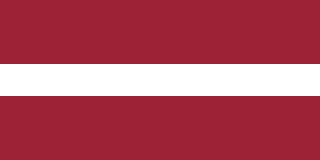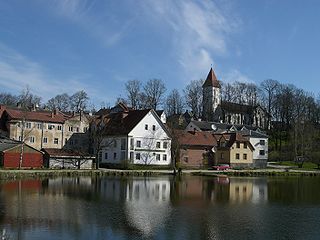External links
Wikimedia Commons has media related to Lakes of Latvia .
List of lakes of Europe | |
|---|---|
| Sovereign states |
|
| States with limited recognition | |
| Dependencies and other entities | |
The following is a list of biggest lakes of Latvia .
| Name | Area | Length |
|---|---|---|
| Lubāns | 80.70 km2 (31.16 sq mi) | 15.6 km (9.7 mi) |
| Rāznas ezers | 57.56 km2 (22.22 sq mi) | 12.1 km (7.5 mi) |
| Engures ezers | 40.46 km2 (15.62 sq mi) | 17.9 km (11.1 mi) |
| Burtnieks | 40.07 km2 (15.47 sq mi) | 13.3 km (8.3 mi) |
| Liepājas ezers | 37.15 km2 (14.34 sq mi) | 16.2 km (10.1 mi) |
| Usmas ezers | 34.69 km2 (13.39 sq mi) | 13.5 km (8.4 mi) |
| Babītes ezers | 25.56 km2 (9.87 sq mi) | 14 km (8.7 mi) |
| Rušons | 23.73 km2 (9.16 sq mi) | 13 km (8.1 mi) |
| Sivers | 17.59 km2 (6.79 sq mi) | 8.1 km (5.0 mi) |
| Ķīšezers | 17.30 km2 (6.68 sq mi) | 8.4 km (5.2 mi) |
| Alūksnes ezers | 15.43 km2 (5.96 sq mi) | 6.6 km (4.1 mi) |
| Riču ezers | 12.83 km2 (4.95 sq mi) [nb 1] | 5.8 km (3.6 mi) |
| Cirma ezers | 12.61 km2 (4.87 sq mi) | |
| Papes ezers | 12.05 km2 (4.65 sq mi) | 8.3 km (5.2 mi) |
| Kaņieris | 11.28 km2 (4.36 sq mi) | 5.2 km (3.2 mi) |
| Ežezers | 9.88 km2 (3.81 sq mi) | 8.2 km (5.1 mi) |
| Lielais Ludzas ezers | 8.46 km2 (3.27 sq mi) | 7.0 km (4.3 mi) |
| Alauksts | 7.75 km2 (2.99 sq mi) | 4.8 km (3.0 mi) |
| Saukas ezers | 7.71 km2 (2.98 sq mi) | 6.2 km (3.9 mi) |
| Drīdzis | 7.53 km2 (2.91 sq mi) | 9.8 km (6.1 mi) |
| Name | Depth |
|---|---|
| Drīdzis | 66.2 m (217 ft) |
| Garais ezers | 56.0 m (183.7 ft) |
| Lielais Gusena ezers | 56.0 m (183.7 ft) |
| Riču ezers | 51.9 m (170 ft) |
| Pļaviņu ūdenskrātuve | 47.0 m (154.2 ft) |
| Geraņimovas Ilzas ezers | 46.0 m (150.9 ft) |
| Ormijs | 43.0 m (141.1 ft) |
| Ojatu ezers | 40.5 m (133 ft) |
| Ušurs | 40.0 m (131.2 ft) |
| Sventes ezers | 38.0 m (124.7 ft) |

Latvia, officially the Republic of Latvia, is a country in the Baltic region of Northern Europe. It is one of the three Baltic states, along with Estonia to the north and Lithuania to the south. It borders Russia to the east, Belarus to the southeast, and shares a maritime border with Sweden to the west. Latvia covers an area of 64,589 km2 (24,938 sq mi), with a population of 1.9 million. The country has a temperate seasonal climate. Its capital and largest city is Riga. Latvians belong to the ethnolinguistic group of the Balts and speak Latvian, one of the only two surviving Baltic languages, a branch of the Indo-European language family. Russians are the most prominent minority in the country, at almost a quarter of the population.

Courland is one of the Historical Latvian Lands in western Latvia. Courland's largest city is Liepāja, which is the third largest city in Latvia. The regions of Semigallia and Selonia are sometimes considered as part of Courland as they were formerly held by the same duke.

Talsi is a town in Latvia. It is the administrative centre of Talsi Municipality. It is nicknamed the "green pearl of Courland".

Riga District was an administrative division of Latvia, located in Semigallia and Vidzeme regions, in the centre of the country. It was the de facto successor of the historical Riga County since 1949.

Latgale, also known as Latgalia is one of the Historical Latvian Lands. It is the easternmost region of the country and lies north of the Daugava River. While most of Latvia is historically Lutheran, Latgale is predominantly Roman Catholic: 65.3% according to a 2011 survey. After the Counter-Reformation it was the northernmost predominantly Catholic province or region in Europe. There is a considerable Eastern Orthodox minority (23.8%), of which 13.8% are Russian Orthodox Christians and 10.0% are Old Believers. As of 2020, the region's population was 255,968.

Madona is a town with town rights in the Zemgale region of Latvia and is the center of the Madona municipality.
Territorial changes of the Baltic states refers to the redrawing of borders of Lithuania, Latvia and Estonia after 1940. The three republics, formerly autonomous regions within the former Russian Empire and before that of former Polish–Lithuanian Commonwealth and as provinces of the Swedish Empire, gained independence in the aftermath of World War I and the Russian Revolution of 1917. After a two-front independence war fought against both Bolshevist Russian and Baltic German nationalist forces, the countries concluded peace and border treaties with Soviet Russia in 1920. However, with World War II and the occupation and annexation of these republics into the Soviet Union twenty years after their independence, certain territorial changes were made in favour of the Russian SFSR. This has been the source of political tensions after they regained their independence with the dissolution of the Soviet Union. Some of the disputes remain unresolved.

Alūksne is a town on the shores of Lake Alūksne in northeastern Latvia near the borders with Estonia and Russia. It is the seat of the Alūksne municipality. Alūksne is the highest elevated Latvian city, located in East Vidzeme Upland at 217 m above sea level. The high elevation of the city affects the social and physical arrangement of the place.
Many Latvians resisted the occupation of Latvia by Nazi Germany. Independent Latvia had been occupied by the Soviet Union in June 1940, then by Nazi Germany in July 1941, forming Generalbezirk Lettland. The Latvian resistance movement was divided between the pro-independence units under the Latvian Central Council and the pro-Soviet units under the Central Staff of the Partisan Movement in Moscow. Daugavpils was the scene of fierce Jewish resistance during the Holocaust. Many local Latvians were actively involved in the resistance movement against the ethnic policies of the German occupation regime. 134 Latvians were later honored with the title Righteous Among the Nations, among them is Žanis Lipke, who risked his life to save more than 50 Jews.
Saldus is a Latvian town located in Courland region of Latvia, and the largest town in Saldus Municipality. The name Saldus has been noted in historical sources as far back as the mid-13th century, but the founding year for the establishment of the town is considered to be 1856, with the settlement gaining town rights in 1917.

Carnikava Municipality is a former municipality in Vidzeme, Latvia. The municipality was formed in 2006 by reorganization of Carnikava Parish of the Riga District, with the administrative centre being Carnikava. The population in 2009 was 6,261 people.

Garkalne Municipality was a municipality in Vidzeme, Latvia. The municipality was formed in 2007 by reorganization of Garkalne Parish. The seat of the council of the municipality is situated extraterritorially in Berģi, Riga. The population in 2020 was 8,923.

Reņģe Manor, also called Ruba Manor, is a manor house for the von Nolcken family that was built between 1881 and 1882 in the historical region of Zemgale, in Latvia. It is located about 2.5 km west of both the village of Ruba and the railroad bridge where the Glūda–Reņģe Railway crosses the Vadakste river along the border of Latvia and Lithuania. Manor building currently houses the Ruba Elementary School.

Bīriņi Palace is a palace in the village of Biriņi (no page), which is a part of the historical region of Vidzeme, in northern Latvia. The castle is surrounded by scenic parks, lakes, a manor house hotel, restaurant, rooms for weddings and seminars. Health serves itself from a variety of activities among horse riding, cycling and boating.

Burtnieki Castle is a castle in Burtnieki Parish, Valmiera Municipality in the Vidzeme region of Latvia. It was built on the south shore of Lake Burtnieks for the Livonian Order around 1284.

Limbaži Municipality is a municipality in Vidzeme, Latvia. The municipality was formed in 2009 by merging Katvari Parish, Limbaži Parish, Pāle Parish, Skulte Parish, Umurga Parish, Vidriži Parish, Viļķene Parish and Limbaži town, with the administrative centre being Limbaži.

Smiltene Municipality is a municipality in Vidzeme, Latvia. The municipality was formed in 2009 by merging the town of Smiltene with the rural parishes of Bilska, Blome, Branti, Grundzāle, Launkalne, Palsmane, Smiltene and Variņi. During the 2021 Latvian administrative reform, the previous municipality was merged with Ape Municipality and Rauna Municipality.

Sēja Manor is a knight's manor in Saulkrasti Municipality in the Vidzeme region of Latvia. It was formerly situated in Kreis Riga in the Governorate of Livonia.

South Kurzeme Municipality is one of the 35 municipalities established in Latvia in 2021. It surrounds Liepāja, Latvia's third largest city. Its first elected municipal council took office on 1 July 2021. Its seat is at Grobiņa.